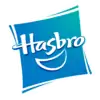Play-Doh
Play-Doh is a modeling compound used by young children for arts and crafts projects at home. The product was first manufactured in Cincinnati, Ohio, United States, as a wallpaper cleaner in the 1930s.[1] Play-Doh was then reworked and marketed to Cincinnati schools in the mid-1950s. Play-Doh was demonstrated at an educational convention in 1956 and prominent department stores opened retail accounts.[2] Advertisements promoting Play-Doh on influential children's television shows in 1957 furthered the product's sales.[1] Since its launch on the toy market in the mid-1950s, Play-Doh has generated a considerable amount of ancillary merchandise such as the Fun Factory.[3]
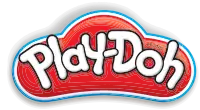 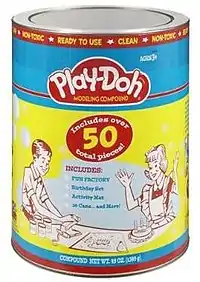 Play-Doh Retro Canister | |
| Type | Modelling clay |
|---|---|
| Company | Kutol (1955) Rainbow Crafts (1956–1971) Kenner (1971–1991) Hasbro (1991–present) |
| Country | United States |
| Availability | 1956–present |
| Official website | |
History
Origin
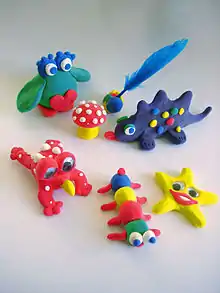
The non-toxic, non-staining, reusable modeling compound that came to be known as "Play-Doh" was a pliable, putty-like substance concocted by Noah McVicker of Cincinnati-based soap manufacturer Kutol Products. It was devised at the request of Kroger Grocery, which wanted a product that could clean coal residue from wallpaper.[4] Following World War II, with the transition from coal-based home heating to natural gas and the resulting decrease in internal soot, and the introduction of washable vinyl-based wallpaper, the market for wallpaper cleaning putty decreased substantially. McVicker's nephew, Joe McVicker, joined Kutol with the remit to save the company from bankruptcy. Joe McVicker was the brother-in-law of nursery school teacher Kay Zufall, who had seen a newspaper article about making art projects with the wallpaper cleaning putty.[5] Her students enjoyed it, and she persuaded Noah McVicker (who also sold the putty) and Joe McVicker to manufacture it as a child’s toy.[5] Zufall and her husband came up with the name Play-Doh; Joe McVicker and his uncle Noah had wanted to call it "Rainbow Modeling Compound".[5]
Launch
Joe McVicker took Play-Doh to an educational convention for manufacturers of school supplies,[1] and Woodward & Lothrop, a department store in Washington, DC began selling the compound.[6] In 1956, the McVickers formed the Rainbow Crafts Company to make and sell Play-Doh.[7] Also in 1956, a three-pack of 7-ounce cans was added to the product line, and, after in-store demonstrations, Macy's of New York and Marshall Field's of Chicago opened retail accounts. In 1957, chemist Dr. Tien Liu reduced Play-Doh's salt content (thus allowing models to dry without losing their color), and Play-Doh ads were telecast on Captain Kangaroo, Ding Dong School, and Romper Room. In 1958, Play-Doh's sales reached nearly $3 million.[1]
Subsequent developments
In 1964, Play-Doh was exported to Britain, France, and Italy.[1] By 1965, Rainbow Crafts issued a patent for Play-Doh.[8] Also in 1965, General Mills bought Rainbow Crafts for $3 million.[1][6] In 1971, Rainbow Crafts and Kenner Products merged, and, in 1987, the Tonka Corporation bought the two. In the 1980s, its cardboard can (with a rust-prone metal bottom) was replaced with a more cost effective plastic container.[9] In 1991, Hasbro became Play-Doh's owner, and continues to manufacture the product today through its preschool division.[1] In 1996, gold and silver were added to Play-Doh's palette to celebrate its 40th anniversary.
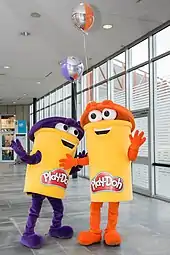
Mascots
Play-Doh packaging was briefly illustrated with children in the mid-1950s, but replaced by the Play-Doh Pixie, an elf mascot which, in 1960, was superseded by Play-Doh Pete, a smock and beret-wearing cartoonish boy. [1] [10] By 2000, Play-Doh Pete's beret had been replaced with a baseball cap.[1] Since 2012, the Doh-Dohs are the mascots.
Ingredients
Play-Doh's current manufacturer, Hasbro, says the compound is primarily a mixture of water, salt, and flour,[2] while its 2004 United States patent indicates it is composed of water, a starch-based binder, a retrogradation inhibitor, salt, lubricant, surfactant, preservative, hardener, humectant, fragrance, and color.[11] A petroleum additive gives the compound a smooth feel, and borax prevents mold from developing.[3] Play-Doh contains some wheat and may cause allergic reactions in people who are allergic to wheat gluten. It is not intended to be eaten.[12]
Related merchandise
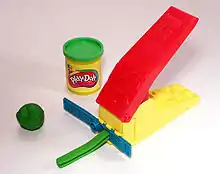
In 1960, the Play-Doh Fun Factory (a toy press that extrudes the compound in various shapes) was invented by Bob Boggild and Bill Dale.[1] The Play-Doh Fuzzy Pumper Barber & Beauty Shop of 1977 and Mop Top Hair Shop of 1986 featured a figurine whose extruded "hair" could be styled. In 1995 an educational software CD-ROM game, Play-Doh Creations was released. In 2003, the Play-Doh Creativity Table was sold. Play-Doh related merchandise introduced during the 2007 anniversary year included the Play-Doh Birthday Bucket, the Play-Doh Fifty Colors Pack, the Fuzzy Pumper Crazy Cuts (a reworking of the 1977 Fuzzy Pumper Barber & Beauty Shop), and the Play-Doh Creativity Center.[3] In 2012, "Play-Doh Plus" was introduced. It is lighter, more pliable, and softer than regular Play-Doh.
Cultural impact
More than two billion cans of Play-Doh were sold between 1955 and 2005,[1] and, in 2005, Play-Doh was being sold in 75 countries at 95 million cans a year.[1] In the United States, more than 6,000 stores carry Play-Doh.[13]
To mark Play-Doh's fiftieth anniversary, Demeter Fragrance Library created a limited-edition fragrance inspired by Play-Doh's distinctive odor for "highly-creative people, who seek a whimsical scent reminiscent of their childhood."[2]
Play-Doh was inducted into the National Toy Hall of Fame at The Strong in Rochester, New York, in 1998.
In 2003, the Toy Industry Association placed Play-Doh into its "Century of Toys List", a roll call of the 100 most memorable and most creative toys of the twentieth century.
In late 2014, the company offered to replace the "Play-Doh Cake Mountain" playset's extruder tool, for free, after receiving complaints about the tool's "phallic shape".[14]
Film
On April 2, 2015, 20th Century Fox announced work on a movie with Hasbro Studios along with its subsidiary company Allspark Pictures and Chernin Entertainment producing, Jason Micallef writing, and Paul Feig directing from his production company Feigco.[15]
See also
References
- Walsh, Tim (2005). "Play-doh". Timeless Toys: Classic Toys and the Playmakers Who Created Them. Kansas City: Andrews McMeel Publishing. pp. 115–120. ISBN 978-0-7407-5571-2.
- Wilson, Tracy V. "How Play-Doh Modeling Compound Works". How Stuff Works. Retrieved February 19, 2009.
- Sobey, Edwin J.C.; Woody Sobey (2008). The Way Toys Work: The Science Behind the Magic 8 Ball, Etch A Sketch, Boomerang, and More. Chicago Review Press. p. 96. ISBN 978-1-55652-745-6.
- "Accidental Brands", from Under the Influence, by Terry O'Reilly, on CBC.ca; first broadcast March 17, 2012
- Greg Hatala (January 28, 2014). "Made in Jersey: Play-Doh is a Dover teacher's handiwork". NJ.com, The Star-Ledger. Retrieved April 16, 2016.
- "Rainbow Crafts Company, Inc". Ohio History Central. July 28, 2006. Retrieved October 30, 2008.
- Phil Ament. "Play-Doh History – Invention of Play-Doh". Ideafinder.com. Archived from the original on June 7, 2011. Retrieved May 23, 2011.
- Noah W. McVicker and Joseph S. McVicker, "Plastic modeling composition of a soft, pliable working consistency," U.S. patent no. 3,167,440 (filed: May 17, 1960; issued: January 26, 1965).
- "The 50 Year History of Play-Doh". 2006. Archived from the original on May 15, 2006. Retrieved February 19, 2009.
- Whatever Happened to Play-Doh Pete?
- "Google Patents". Retrieved July 28, 2014.
- "FAQ". Play-Doh. Archived from the original on November 11, 2018. Retrieved April 1, 2019.
- HowStuffWorks "How Play-Doh Modeling Compound Works"
- Respers France, Lisa. "Play-Doh will exchange phallic-shaped toy". CNN.com. Retrieved January 3, 2015.
- Fleming, Jr, Mike (April 2, 2015). "Fox Molding 'Play-Doh' Film With Paul Feig Circling; Another Hasbro Toy Brand Making Movie Transfer". Deadline.
External links
- Play-Doh began as wall cleaner | Our History
- Playmakers Part II: Play-Doh
- The Accidental Invention of Play-Doh, by David Kindy, smithsonian.com, November 12, 2019
| Wikimedia Commons has media related to Play-Doh. |
